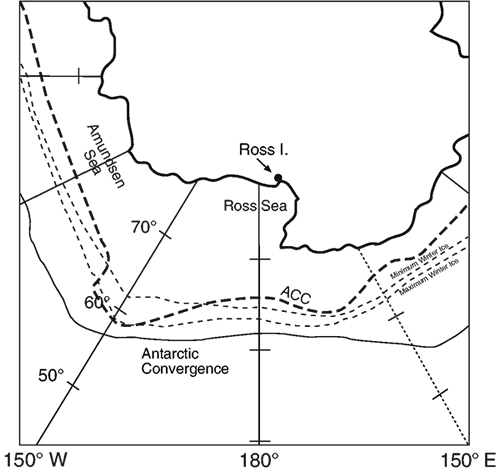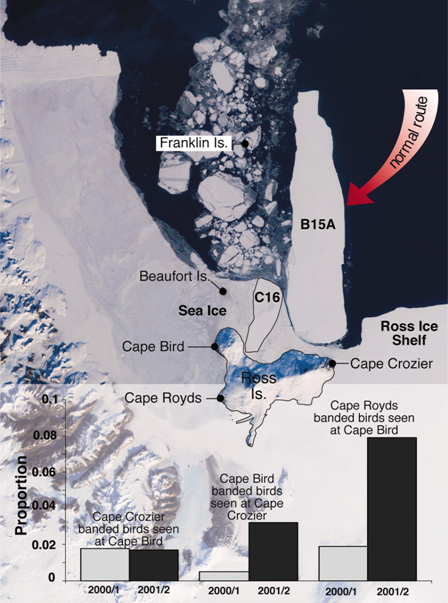Population trends
The sizes of Adélie penguin breeding populations on Ross Island have been measured annually for over 30 years – one of the longest continuing sets of data involving a marine organism in the Antarctic. Considerable variability exists from one year to the next.
We hypothesised that changes are related to natural environmental factors such as:
- Surface–air temperatures
- Meridional winds
- Factors relating to the Southern Oscillation (SO)
- Aspects of sea-ice including:
- ice range
- max. ice concentration
- max/min ice area
- max/min ice extent
- satellite data on sea-ice
Using path analysis to analyse annual variation in population growth in relation to these environmental factors, we have found that annual population growth measured during summer was explained best by relating it to the extent of sea-ice in the study area five winters earlier. Sea-ice itself is also related to the SO.

Modelling our data has indicated that the number of breeding pairs is inversely related to the maximal sea ice with a 5-year lag (r2 = 0.97; P < 0.0001).
In winter Adélies feed in a 200-km-wide band around Antarctica where the concentration of pack ice is between 15 and 80%. This region normally coincides with the food-rich waters lying south of the southern boundary of the Antarctic Circumpolar Current (ACC). In years of more extensive sea-ice, access to this food-rich region is limited. Although adult Adélies are unaffected, naive and inexperienced juvenile and subadult penguins are much more vulnerable to starvation and predation. Five years later when these young birds would normally be recruited into the breeding population, there is a dip in the number of breeding pairs due to low recruitment.

Sea-ice in Antarctica can fluctuate markedly over both annual and longer periods. Some years, winter sea-ice can cover up to 40% of the Southern Ocean! Since 1970, satellites have recorded changes in the cycling of winter sea-ice with a trend towards two good years followed by five warmer years with less ice.
Social factores that regulate Adélie populations
Adelie colonies are not discrete units, the growth and decline greatly influenced by neighbouring colonies. Adelies are far less phylopatric than first thought andn when foraging conditions deteriorate juveniles move elsewhere andeventually breeding adults will move.
 |
| Icebergs B15A and C16 blocking access to the penguin colonies on Ross Island and the impact on migration rates between colonies. |
For more information:
Ainley DG, Clarke ED, Arrigo K, Fraser WR, Kato A, Barton KJ, Wilson PR 2005. Decadal-scale changes in the climate and biota of the Pacific sector of the Southern Ocean, 1950s to the 1990s. Antarctic Science, 17 (2): 171-182.
Dugger KM, Ainley DG, Lyver PO'B, Barton K, Ballard G 2010. Survival differences and the effect of environmental instability on breeding dispersal in an Adélie penguin meta-population. PNAS 107(27): 12375-12380.
Shepherd LD, Millar CD, Ballard G, Ainley DG, Wilson PR, Haynes GD, Baroni C, Lambert DM 2005. Microevolution and mega-icebergs in the Antarctic. PNAS, 102(46): 16717-16722.
Wilson PR, Ainley DG, Nur N, Jacobs SS, Barton KJ, Ballard G, Comiso JC 2001. Adélie penguin population change in the Pacific sector of Antarctica: Relation to sea-ice extent and the Antarctic Circumpolar Current. Marine Ecology Progress Series 213: 301–309.
